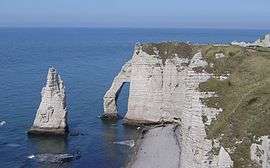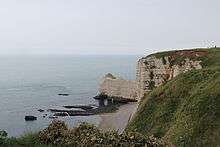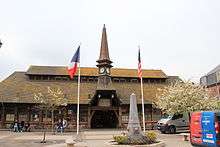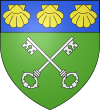Étretat
| Étretat | ||
|---|---|---|
 | ||
| ||
 Étretat | ||
|
Location within Normandy region  Étretat | ||
| Coordinates: 49°43′N 0°13′E / 49.71°N 0.21°ECoordinates: 49°43′N 0°13′E / 49.71°N 0.21°E | ||
| Country | France | |
| Region | Normandy | |
| Department | Seine-Maritime | |
| Arrondissement | Le Havre | |
| Canton | Criquetot-l'Esneval | |
| Intercommunality | Canton of Criquetot-l'Esneval | |
| Government | ||
| • Mayor (2008–2014) | Franck Cottard | |
| Area1 | 4.07 km2 (1.57 sq mi) | |
| Population (2011)2 | 1,461 | |
| • Density | 360/km2 (930/sq mi) | |
| Time zone | CET (UTC+1) | |
| • Summer (DST) | CEST (UTC+2) | |
| INSEE/Postal code | 76254 / 76790 | |
| Elevation |
0–102 m (0–335 ft) (avg. 8 m or 26 ft) | |
|
1 French Land Register data, which excludes lakes, ponds, glaciers > 1 km² (0.386 sq mi or 247 acres) and river estuaries. 2 Population without double counting: residents of multiple communes (e.g., students and military personnel) only counted once. | ||
Étretat is a commune in the Seine-Maritime department in Normandie region in north-western France. It is a tourist and farming town situated about 32 km (20 mi) northeast of Le Havre, at the junction of the D 940, D 11 and D 139 roads. It's located on the coast of the Pays de Caux area.
The cliffs

Étretat is best known for its cliffs, including three natural arches and the pointed "needle". These cliffs and the associated resort beach attracted artists including Eugène Boudin, Gustave Courbet and Claude Monet, and were featured prominently in the 1909 Arsène Lupin/Lupin the Third novel The Hollow Needle by Maurice Leblanc.
Two of the three famous arches are seen from the town, the Porte d'Aval, and the Porte d'Amont. The Manneporte is the third and the biggest one, and cannot be seen from the town.
The GR 21 long-distance hiking path (Le Havre to Le Tréport) passes through the town.
The White Bird
Étretat is known for being the last place in France from which the 1927 biplane The White Bird (L'Oiseau Blanc) was seen. French World War I war heroes Charles Nungesser and François Coli were attempting to make the first non-stop flight from Paris to New York City, but after the plane's 8 May 1927 departure, it disappeared somewhere over the Atlantic. It is considered one of the great unexplained mysteries of aviation. A monument to the flight was established in Étretat, but destroyed during World War II, during German occupation. A new and taller monument was constructed in 1963, along with a nearby museum.[1]
Demographics
|
 Panorama of the cliffs |
Economy

The economy of Étretat rests mainly on tourism, which gives the locals a growing commercial outlet. The city places itself as the number one tourist attraction in former Normandy, as the site most visited along with Bénédictine distillery and museum at Fécamp, the Rouen Cathedral and the Claude Monet Foundation in Giverny.
During the eighteenth and nineteenth centuries the economy was supplemented by kelp-burning on the beaches. The white plumes of smoke by the shore can be clearly seen in George Inness' painting 'Étretat' (1875, Wadsworth Athenaeum). "The discovery and development of iodine-rich mineral deposits in Chile about the same time the iodine-from-kelp industry reached full vigor, dealt the kelp industry another severe blow in the late 1870's. However, small quantities of kelp continued to be harvested for soda, potash and iodine in northern France".[2]
Notable people
Étretat was the birthplace of Élie Halévy (1870–1937), philosopher and historian.
Guy de Maupassant (1850–1893) spent most of his childhood in Étretat, at "Les Verguies". In 1882 he wrote a short story for Le Gaulois entitled "The Englishman of Étretat" (L'Anglais d'Étretat), based on encounters in 1868, as a house guest of G. E. J. Powell, with the English poet Algernon Charles Swinburne, whom he had helped save from drowning. The dried human hand displayed on one of the tables was later acquired by Maupassant to adorn his Paris apartment; it inspired another short story, "The Flayed Hand" (La Main Écorchée).[3] In 1883 he built his own house in Étretat, "La Guillette", in the Mediterranean style in "Le Grand Val", since renamed rue Guy-de-Maupassant.[4] Jean-Baptiste Faure (1830–1914), the great French operatic baritone whose career centred on Paris and London, also owned a villa there. A friend of the artist Édouard Manet and a keen collector of art, Faure did amateur paintings of the local area, including the scenic cliff. Claude Monet did several paintings in the area particularly of the natural cliff arches and stacks.
Gallery
 Gustave Courbet, 1870
Gustave Courbet, 1870 Vasily Polenov, 1874
Vasily Polenov, 1874 Claude Monet, 1883
Claude Monet, 1883
See also
References
- ↑ Schofield, Brian (2002-09-22). "Hop over: five-day drives just across the Channel - France". Sunday Times.
- ↑ Lobban, Christopher S.; Wynne, Michael James (1971). The Biology of Seaweeds. University of California Press. ISBN 978-0520045859.
- ↑ Goddard, N. G. (1952). "Maupassant and the English". French Studies. VI: 35–40. doi:10.1093/fs/VI.1.35.
- ↑ "History of La Guillette". Houseofmaupassant.com. Retrieved 2012-06-05.
External links
| Wikivoyage has a travel guide for Étretat. |
| Wikimedia Commons has media related to Étretat. |
- Official website (French)
- Alternative site of Étretat (French)
- Etretat Normandie blog - To discover Etretat with a local resident who loves this city. You can look for your stay with this blog too. (French)
- Website of an artist living in Étretat (French)
- 3D view from Google Earth of part of Étretat's cliffs (French)
- Étretat on the Quid website (French)
- The full story of English eccentric Algernon Swinburne's near drowning at Etretat and his meeting with Maupassant (English)
